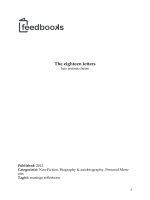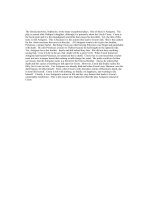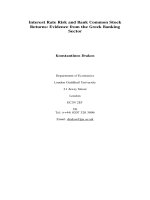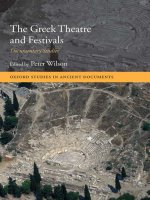CH15 the greek letters
Bạn đang xem bản rút gọn của tài liệu. Xem và tải ngay bản đầy đủ của tài liệu tại đây (428.93 KB, 22 trang )
15.1
The Greek Letters
Chapter 15
15.2
Example
A bank has sold for $300,000 a European call option
on 100,000 shares of a nondividend paying stock
S0 = 49, K = 50, r = 5%, σ = 20%,
T = 20 weeks, µ = 13%
The Black-Scholes value of the option is $240,000
How does the bank hedge its risk to lock in a
$60,000 profit?
15.3
Naked & Covered Positions
Naked position
Take no action
Covered position
Buy 100,000 shares today
Both strategies leave the bank
exposed to significant risk
15.4
Stop-Loss Strategy
This involves:
Buying 100,000 shares as soon as
price reaches $50
Selling 100,000 shares as soon as
price falls below $50
This deceptively simple hedging
strategy does not work well
15.5
Delta (See Figure 15.2, page 345)
Delta (∆) is the rate of change of the
option price with respect to the underlying
Option
price
A
B
Slope = ∆
Stock price
15.6
Delta Hedging
This involves maintaining a delta neutral
portfolio
The delta of a European call on a stock
paying dividends at rate q is N (d 1)e– qT
The delta of a European put is
e– qT [N (d 1) – 1]
15.7
Delta Hedging
continued
The hedge position must be frequently
rebalanced
Delta hedging a written option involves a
“buy high, sell low” trading rule
See Tables 15.2 (page 350) and 15.3
(page 351) for examples of delta hedging
15.8
Using Futures for Delta Hedging
The delta of a futures contract is e(r-q)T
times the delta of a spot contract
The position required in futures for delta
hedging is therefore e-(r-q)T times the
position required in the corresponding spot
contract
15.9
Theta
Theta (Θ) of a derivative (or portfolio of
derivatives) is the rate of change of the value
with respect to the passage of time
The theta of a call or put is usually negative.
This means that, if time passes with the price of
the underlying asset and its volatility remaining
the same, the value of the option declines
15.10
Gamma
Gamma (Γ) is the rate of change of
delta (∆) with respect to the price of the
underlying asset
Gamma is greatest for options that are
close to the money (see Figure 15.9,
page 358)
15.11
Gamma Addresses Delta Hedging
Errors Caused By Curvature
(Figure 15.7, page 355)
S
C
Stock price
S'
Call
price
C''
C'
15.12
Interpretation of Gamma
For a delta neutral portfolio,
∆Π ≈ Θ ∆t + ½Γ∆S 2
∆Π
∆S
Negative Gamma
∆Π
∆S
Positive Gamma
15.13
Relationship Between Delta,
Gamma, and Theta
For a portfolio of derivatives on a stock
paying a continuous dividend yield at
rate q
Θ ∆ Γ Π+ − + =
( )r q S S r
1
2
2 2
σ
15.14
Vega
Vega (ν) is the rate of change of the
value of a derivatives portfolio with
respect to volatility
Vega tends to be greatest for options
that are close to the money (See Figure
15.11, page 361)
15.15
Managing Delta, Gamma, & Vega
·
∆ can be changed by taking a position in the
underlying
To adjust Γ & ν it is necessary to take a
position in an option or other derivative
15.16
Rho
Rho is the rate of change of the
value of a derivative with respect
to the interest rate
For currency options there are 2
rhos
15.17
Hedging in Practice
Traders usually ensure that their portfolios
are delta-neutral at least once a day
Whenever the opportunity arises, they
improve gamma and vega
As portfolio becomes larger hedging
becomes less expensive
15.18
Scenario Analysis
A scenario analysis involves testing the
effect on the value of a portfolio of different
assumptions concerning asset prices and
their volatilities
15.19
Hedging vs Creation of an Option
Synthetically
When we are hedging we take
positions that offset ∆, Γ, ν, etc.
When we create an option
synthetically we take positions
that match ∆, Γ, & ν
15.20
Portfolio Insurance
In October of 1987 many portfolio
managers attempted to create a put
option on a portfolio synthetically
This involves initially selling enough of
the portfolio (or of index futures) to
match the ∆ of the put option
15.21
Portfolio Insurance
continued
As the value of the portfolio increases, the
∆ of the put becomes less negative and
some of the original portfolio is
repurchased
As the value of the portfolio decreases,
the ∆ of the put becomes more negative
and more of the portfolio must be sold
15.22
Portfolio Insurance
continued
The strategy did not work well on October
19, 1987









